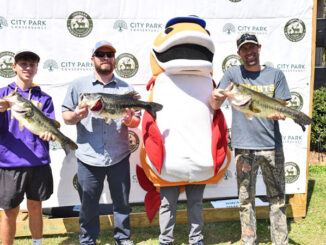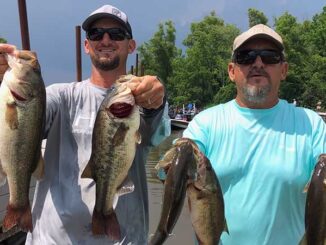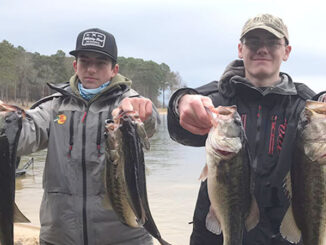Against all odds, small bayou produces good winter bass fishing
As bass fishermen, it’s been ingrained into us that we should target deep water during the winter months. The logic is fairly simple: bass retreat to deep water to escape the frigid temperatures.
And while there’s no doubt that targeting deep water has proven to produce bass every winter for anglers, it’s probably not a good idea to eliminate shallow water altogether.
Case in point: Bayou Cane.
Located on the northern shoreline of Lake Pontchartrain, Bayou Cane appears to be a no-go when it comes to wintertime bass fishing. This “baby bayou” spans a whopping 1.2 miles from its inception just north of Hwy 190, to when it empties into the lake just east of Fontainebleau State Park.
Throughout its short existence, the tributary never exceeds a depth of 9 feet, with the average depth being 5 feet. With these attributes, it’s no wonder that it took me 30 years to discover that Cane excels in the winter even when the water temperatures dip into the 40s.
Discovering Bayou Cane
My discovery began back in 2015 when I met John Farley. Farley grew up in Lacombe and has been fishing Bayou Cane since he was a kid. I was working on a video series that focused on winter fishing and admittedly needed his help given the lifelong knowledge he acquired through the years. However, when he suggested that we fish Bayou Cane in February, I have to admit I began to doubt that knowledge.
I met Farley on a cold morning at the public boat launch across from the Mandeville Fire Station on Hwy 190. A cold front just had passed through, which led to the both of us dressed as if we were fishing the Kenai rather than Cane. As I shook hands with Farley I was also shaking my head side to side insinuating that this (and he) were crazy.
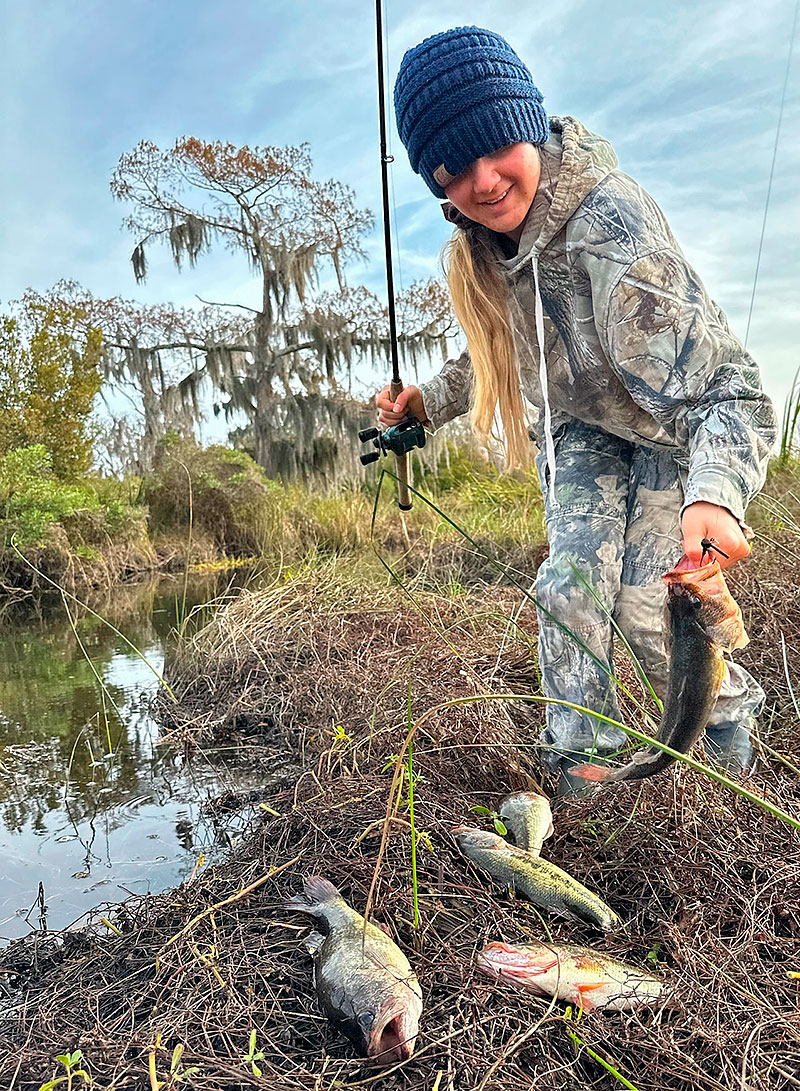 To this, he responded with an affirming smile and said, “Trust me.”
To this, he responded with an affirming smile and said, “Trust me.”
My trust in the plan slowly set in as we made our way south. The water was gin clear and was forecasted to fall all morning. Our first spot was a small trenasse that spilled out of the marsh on the eastern side of Cane. The water was pouring out and this is where my introduction began.
“This is what you’re looking for in the winter,” Farley said. “There are only a few of these drains in the bayou, but because of this reason, the bass are almost guaranteed to be gathered in the holes when the water temperatures dip.”
Farley positioned his flatboat along the bank on the opposite side of the ditch. We were using Texas-rigged Blue Saphire Baby Brush Hogs with a 1/8-ounce worm weight and began casting towards the trenasse.
The current rolled the bait on the bottom until it dropped off a ledge and that was where the magic happened. On his second cast, Farley was letting the lure roll on the bottom with a slight bow in his line. I felt a sudden shift in the boat and he set the hook. As he was reeling in his fish I saw my line move to the right. After two revolutions of the reel handle, I took a swing and connected. Within five minutes we put two decent bass in the boat and into the ice chest. The following casts resulted in another fish for Farley and a swing-and-a-miss for me as I set the hook a little too quickly.
“When it’s cold I like to slow everything down,” Farley said. “Not only my retrieve but my hookset. When it’s cold like this these fish’ll hold on to that soft plastic longer than normal.”
As I slowed my presentation down I also forced myself to give the fish an extra second or two before setting the hook and it paid off as I caught two fish on four casts. We fished the same spot for nearly an hour repeating the same technique and ended up with 20 bass before heading back to the launch.
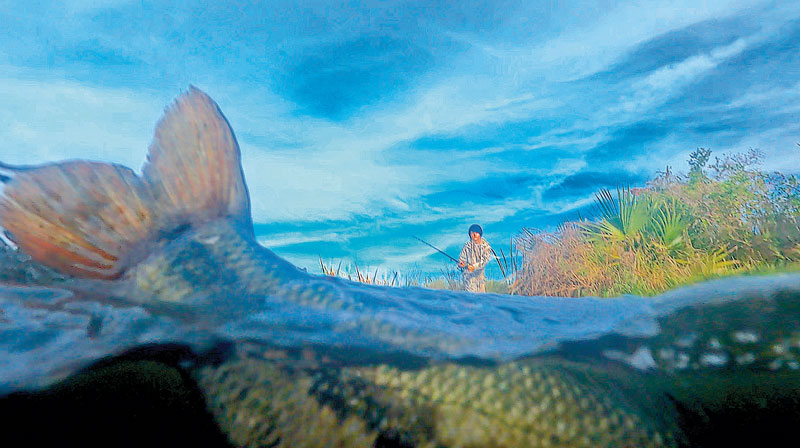
Woods vs. Marsh
Since my introduction to wintertime bass fishing on Bayou Cane, I’ve been fishing the bayou exclusively in the winter and have learned what areas to fish and what areas to stay away from. Bayou Cane is a unique tributary that contains two areas with completely different topographies. As you launch, you’ll notice that the bayou is heavily wooded to the point of being shaded in numerous stretches as it meanders south. While this wooded area is great for providing bass with cooler water because of the overhangs, I find that it struggles to produce fish mid-winter because of shade and the lack of deep holes.
It’s along this wooded section on Cane where you’ll find the late Chef Justin Wilson’s home. The 18,000-square-foot mansion stands 24 feet tall and contains 12 rooms. It was at this location that Wilson filmed his cooking show called “Louisiana Cooking: At Home.” As you move south past the mansion you’ll notice that the wooded section of the bayou turns to marsh and remains that way until it reaches the lake. This is the section of the bayou that you’ll want to focus on because it contains the deepest holes. The deep holes are located in the middle of the bayou near the drains that spill out of the marsh.
Winter setup
When fishing Cane in the winter, it’s important to temper your line size because of the water clarity. In February, the water is incredibly clear. Any line heavier than 10-pound test is too heavy and will be spotted by the fish. As far as lures go, I find that Baby Brush Hogs or downsized jigs catch the most fish with colors like black and blue working best.
Because of the narrow width of Bayou Cane, I like to position my boat along the shoreline opposite the drain where I’m fishing. The bayou is narrow enough to make long casts into the drain. After that, it’s all about patience. I like to keep a slight bow in my line raising the rod and slowly turning the reel handle so that the lure drags the bottom.
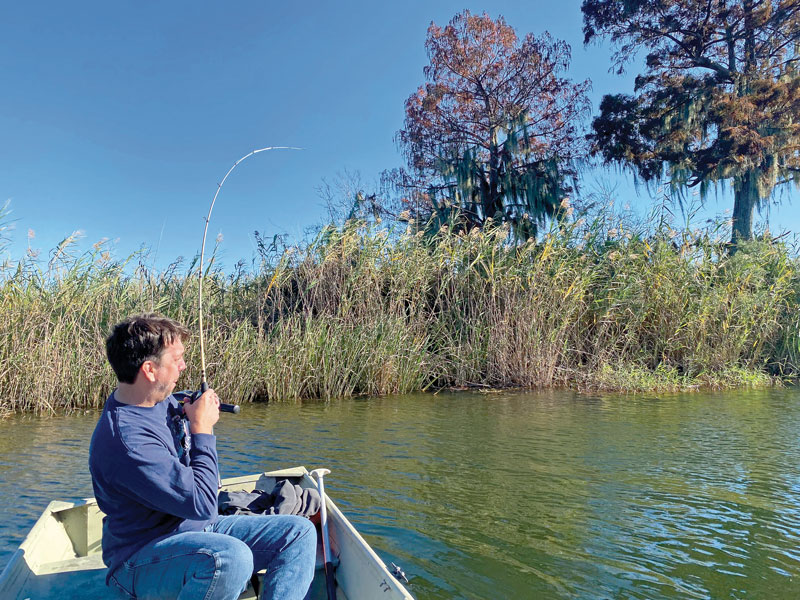
February limit
On my latest trip to Bayou Cane, I decided to bring my daughter Kasey. We launched our flatboat just after 8 a.m. and headed south straight to the first drain located on the eastern shoreline of the bayou. We were throwing black and blue Rattling Football Jigs made by Delta Lures. Unfortunately, the day started slow as we came up empty during the first 20 minutes of fishing.
I knew the bite would turn on as the sun rose but I was impatient and wanted to move to the next drain. However, Kasey had missed two bites and wanted to stay. It was at that moment that I saw a little of me in her as she asked if she could fish from land while I went and checked out the other drain. I was famous for getting out of my dad’s boat and fishing the marsh from land when I was a kid. Normally I would never let her fish from the marsh along Bayou Cane because of the alligators, but being that it was 34 degrees I felt confident that we wouldn’t see any gators.
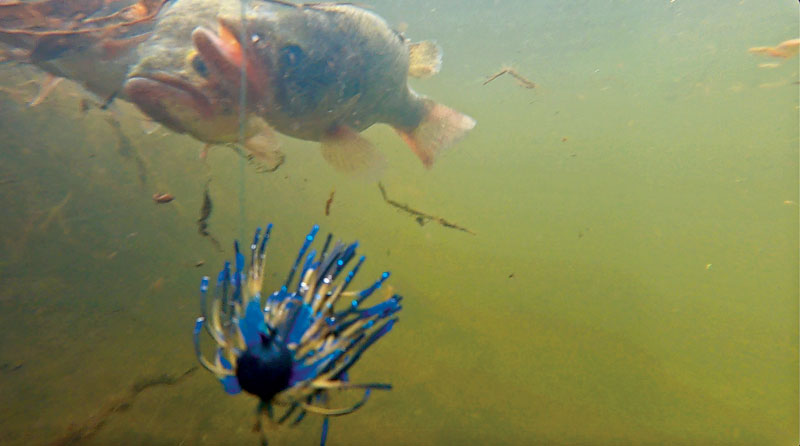
I proceeded to motor south to the next drain and that’s where I found the fish. On my first cast, I dragged the jig along the bottom and let it drop off a slight ledge. Then I felt a thump and set the hook on a 2-pound bass. After boating it, I debated on whether I should go back and pick up Kasey but decided to see if there were more bass in the hole. I repeated my technique of slow-dragging the jig on the bottom and was able to put nine more bass in the ice chest. Since I didn’t hear from Kasey I assumed that she wasn’t catching anything, so I went to pick her up to take her back and finish up our limit.
As I approached, I saw her reel in a bass and sling it onto the shore. At her feet were four more bass that she caught while I was gone.
She then pointed me to the other side and yelled, “Pull over there and cast right here!” I did so and felt a solid thump in the middle of the bayou and set the hook. Just then, Kasey set the hook and we both reeled in our fish at the same time as Kasey yelled “Doubled up! Doubled up!” Needless to say, it didn’t take us long to finish off our limit and we were back in the truck (with the heater blasting) by 11 a.m.
Looking back, this is just one of several very successful trips that Kasey and I have made over the years. Bayou Cane has become our go-to winter bass fishing destination because of the limited amount of deep holes. As February passes there’s still time to fish these holes where the bass stack up, however, as the weather turns warmer these fish will be headed to the shallows for the spawn, and this mid-winter technique of catching will be over and done with until next winter.
